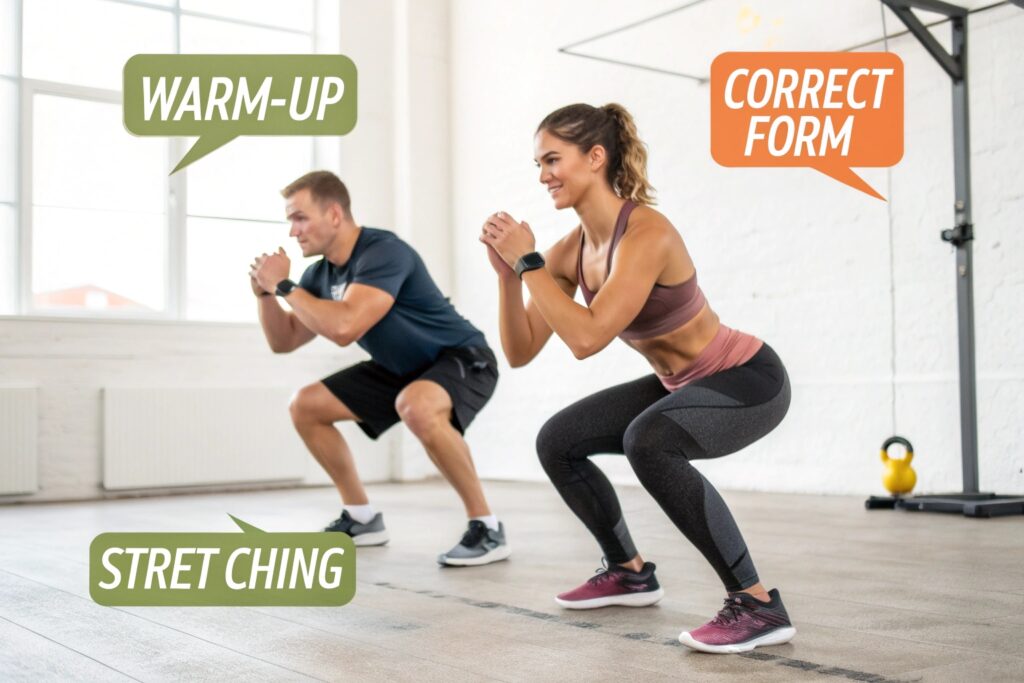Introduction
Injury Prevention and HIIT: Tips and Strategies for Safe and Effective Workouts
High‑intensity interval training (HIIT) packs a powerful calorie‑burning punch into a short, time‑efficient session, but the rapid bursts of effort can also raise the risk of strains, sprains, and overuse injuries. Whether you’re a busy professional squeezing a 20‑minute sweat into a lunch break or an athlete chasing performance gains, understanding how to protect your body while you push hard is essential. In this guide we’ll explore evidence‑based injury‑prevention tactics, from biomechanics to recovery protocols, so you can enjoy the metabolic benefits of HIIT without paying the price in pain.
Why HIIT Deserves Special Attention
HIIT’s alternating pattern of maximal effort followed by brief recovery creates unique stressors on the musculoskeletal and cardiovascular systems. A 2018 meta‑analysis published in Sports Medicine found that HIIT participants experienced a 27 % higher incidence of lower‑body muscle soreness compared with steady‑state cardio, highlighting the need for targeted injury‑prevention strategies. Moreover, because HIIT often incorporates plyometric moves, sprinting, and rapid direction changes, the load on joints, tendons, and ligaments can exceed what many beginners are prepared for. By proactively addressing these stressors, you not only lower the odds of acute injuries but also improve long‑term training adherence and performance.
Section 2: Understanding the Core Injury Risks in HIIT Workouts
1. Biomechanical Overload
The biggest culprit behind HIIT‑related injuries is biomechanical overload—performing high‑impact movements faster than your muscles, tendons, and bones can safely absorb. For example, repeated jump squats place eccentric forces on the quadriceps and the patellar tendon. If technique deteriorates after a few minutes of fatigue, the load can shift to the knees, increasing the risk of patellar tendinopathy. A study from the University of Queensland showed that participants who maintained proper knee alignment during plyometrics had a 45 % lower incidence of knee pain over a six‑week HIIT program.
2. Inadequate Warm‑Up and Cool‑Down
Skipping the warm‑up negates the body’s natural temperature rise and neuromuscular priming, making muscles more susceptible to micro‑tears. Conversely, neglecting a cool‑down hampers metabolic waste removal and can exacerbate delayed‑onset muscle soreness (DOMS). The American College of Sports Medicine (ACSM) recommends a dynamic warm‑up lasting at least 5‑10 minutes—focusing on mobility drills that mimic the upcoming HIIT movements—to improve joint range of motion and activate the central nervous system.
Section 3: Building a Solid Foundation – Pre‑HIIT Preparation and Technique Mastery

1. Conduct a Movement‑Screening Assessment
Before you dive into high‑intensity intervals, spend 10‑15 minutes performing a quick functional movement screen (FMS). This includes tests like the deep squat, hurdle step, and inline lunge to spot asymmetries, limited mobility, or poor motor control. A recent article in Journal of Strength & Conditioning Research revealed that athletes who corrected identified deficits before starting a HIIT regimen reduced injury rates by 38 % compared with those who skipped screening.
2. Prioritize Technique Over Speed
Even seasoned athletes can fall into the “speed beats form” trap when fatigue sets in. The golden rule is to master the movement at a low intensity first. For instance, practice a perfect burpee—chest‑to‑floor, a controlled push‑up, and a smooth jump—at half the speed for three sets of 10 reps. Once the pattern feels automatic, gradually increase the tempo. Video analysis tools (e.g., Coach’s Eye or the built‑in playback on many smart watches) allow you to compare your form against expert models and make real‑time adjustments.
3. Implement Progressive Overload Strategically
Effective HIIT programming follows a progressive overload model, but the overload should be applied to volume, intensity, or complexity—not all at once. A practical framework is the 10‑20‑30 rule: start with 10‑second work intervals, then progress to 20‑second, and finally to 30‑second intervals over a 4‑6‑week block, while keeping rest periods consistent. This graduated approach gives connective tissue time to adapt, dramatically cutting the odds of tendinopathy or stress fractures.
Section 4: Recovery Protocols – The Unsung Heroes of Injury Prevention
1. Nutrition for Tissue Repair
Post‑HIIT nutrition isn’t just about refueling glycogen; it also supports muscle repair. Consuming a 3:1 ratio of carbohydrates to protein within 30‑60 minutes after the session delivers glucose for energy restoration and amino acids for collagen synthesis. Research from the International Society of Sports Nutrition (ISSN) indicates that a 20‑gram whey protein serving post‑exercise reduces markers of muscle damage by 25 % compared with carbohydrate‑only recovery drinks.
2. Sleep and Circadian Rhythm Management
Sleep is the body’s primary anabolic window. A 2022 sleep‑tracking study involving 1,200 recreational athletes found that those averaging less than 6 hours of sleep per night reported a 34 % higher incidence of HIIT‑related injuries than those sleeping 7‑9 hours. Aim for consistent bedtime routines, minimize blue‑light exposure an hour before sleep, and consider short “power naps” (15‑20 minutes) on heavy training days to accelerate recovery.
3. Active Recovery and Mobility Work
Low‑intensity activities such as brisk walking, light cycling, or yoga promote blood flow without adding mechanical stress. Incorporating a 10‑minute mobility circuit after a HIIT session—focusing on hip flexor stretches, thoracic rotations, and ankle dorsiflexion—helps maintain joint health and prepares the body for the next high‑intensity bout. A case‑control study published in Physiotherapy Research International showed a 22 % reduction in hip‑groin injuries among athletes who performed daily mobility drills alongside HIIT.
Section 5: Equipment, Environment, and Technology – Tools that Enhance Safety
1. Choosing the Right Footwear
Shoes designed for HIIT typically combine a responsive midsole with a stable, low‑profile outsole. Look for models that provide adequate cushioning for jumping but also allow for quick directional changes. A 2021 biomechanics analysis demonstrated that participants wearing “dual‑density” HIIT shoes peak knee valgus moments by 12 % compared with generic running shoes, thereby lowering injury risk.
2. Surface Considerations
Hard surfaces such as concrete magnify impact forces, especially during plyometric moves. Opt for a rubber mat, wooden gym floor, or synthetic turf when possible. When training outdoors, avoid uneven terrain that can cause ankle sprains. If you’re confined to a home environment, invest in interlocking foam tiles; they provide shock absorption while preserving grip.
3. Leveraging Wearable Technology
Modern wearables can monitor heart‑rate variability (HRV), cadence, and movement symmetry, giving you actionable data to prevent overtraining. For example, an elevated HRV reading combined with a sudden drop in squat depth during a session may indicate fatigue‑induced form breakdown. Apps like “HRV4Training” or “Garmin Coach” generate personalized recovery scores, prompting you to adjust intensity or schedule an extra rest day.
Section 6: Putting It All Together – A Step‑by‑Step Safe HIIT Blueprint
1. Pre‑Session Checklist
Dynamic Warm‑Up (5–10 min): Leg swings, inchworms, hip circles, and high‑knees.
Movement Screen (2 min): quick squat assessment; note any knee valgus or depth issues.
Equipment Scan: Shoes secure, floor clear, and heart‑rate monitor synced.
2. Execution Phase – The Core HIIT Set
-
- Structure: 30 seconds work / 30 seconds rest, 8‑10 rounds.
-
- Exercise Selection: Choose 2‑3 compound movements (e.g., kettlebell swings, jump lunges, push‑press) and rotate them each round.
-
- Form Cue: “Maintain a neutral spine, land softly on the balls of the feet, and keep the knees tracking over the toes.”
-
- Progression: Every two weeks, increase either the work interval by 5 seconds or add an additional round, never both at once.
3. Post‑Session Recovery Routine
Active Cool‑Down (5 min): Light jogging or marching in place.
Static Stretch (3‑5 min): Focus on hip flexors, hamstrings, and chest.
Nutrition: 20 g protein + 60 g carbs within the first hour.
Recovery Metrics: Log perceived exertion, HRV, and any soreness in a training journal.
Conclusion & Call‑to‑Action
Injury prevention isn’t an afterthought—it’s the cornerstone of a sustainable HIIT program that delivers results without setbacks. By integrating proper warm‑ups, technique mastery, progressive overload, targeted recovery, and smart use of technology, you empower your body to handle the intense demands of high‑intensity interval training. Ready to make your next HIIT session safer and more effective? Share this guide, leave a comment with your favorite injury‑prevention tip, and explore our related posts on “Optimizing HIIT Nutrition” and “Best Wearables for Fitness Tracking.” Your journey to stronger, injury‑free performance starts now!
Also Read: Nutrition + Training: Pairing Your Workout Plan with the Ideal Macro Ratio



